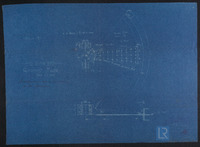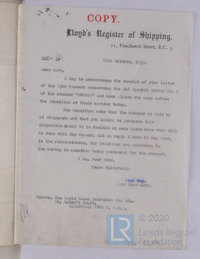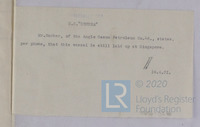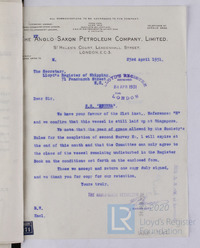- Related documents Related
- Full details Details
- Report document? Report?
Use the data export button to extract customised data sets from the Ship Plan and Survey Report Collection. Available in TSV and CSV formats.
Date recorded as the time of writing.
24/02/1932
The year in which a vessel’s construction is completed.
1913
The individual and/or organisation listed as having been responsible for constructing the vessel. This can/may be the same as the owner and/or manager.
Swan Hunter & Wigham Richardson Ltd
The port or place in which the vessel’s construction took place, at the time of writing.
Wallsend On Tyne
Records that constitute Lloyd’s Register’s first official encounters with a specific vessel, e.g. a survey report.
N
Classification symbol assigned to a vessel by Lloyd’s Register’s Classing Committee denoting the quality of construction and maintenance.
+100A1 1,30; Carrying Petroulem in Bulk fitted for Oil Fuel 11,13 Fp Above; +SS No 3,26; +LMC 4,26; BS 1,30
A vessel’s means of propulsion.
Steam
Is the steamer assisted by sail?
No
Confirmation as to whether the vessel was equipped with refrigeration machinery to aid in the transport of frozen or chilled cargo/goods.
No
Does the vessel possess an auxiliary power source?
No
Is electric lighting fitted to the vessel?
No
The official record pronounced by the Committee
Broken up
Recorded date for the vessel’s loss or disposal.
__/__/0000
Physical extent of a record.
1
Name of ship as recorded on the record
Eburna
The process of transferring a vessel to water, but not necessarily her completion.
14/10/1913
Unique identifier for a given ship, it is assigned by a builder.
929
Official administrative title (often printed) of a record used by Lloyd’s Register or external organisations.
Report of Total Loss, Casualty, &c./ Wreck reports
The individual and/or organisation listed
Anglo Saxon Petroleum Co Ltd
Date of the meeting of the Classing Committee.
26/02/1932
Predominant material(s) utilised in a vessel’s construction.
Steel
A ship’s total internal volume in ‘register tons’ (replaced by gross tonnage post 1982).
4735
Is machinery fitted at the aft of the vessel?
No
Generally a smaller additional auxiliary boiler (often used while the vessel is at port).
No
Name of the Proving House responsible for the public testing and certification of a vessel’s anchors and/or chain cables.
No
Contextual information related to the reasons of the vessel’s loss or disposal.
Sold to Japanese Shipbreakers
Recorded information relating the specific cargo being conveyed.
Petroleum in bulk
Report an issue with this document
Have you noticed missing or incorrect data or images for this document?
Please let us know and we will rectify the issue as soon as possible.









































